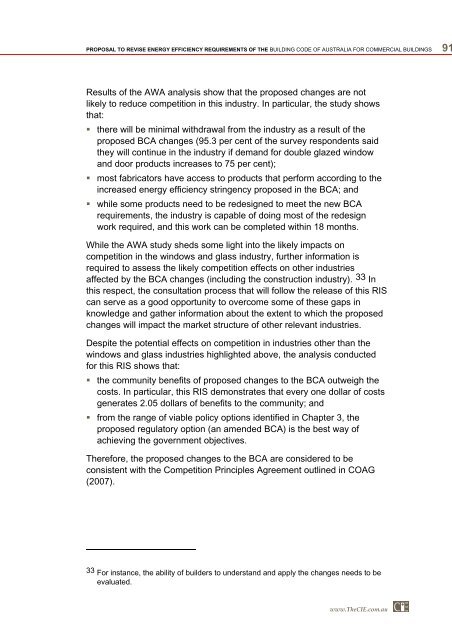PDF | 2 MB - Australian Building Codes Board
PDF | 2 MB - Australian Building Codes Board
PDF | 2 MB - Australian Building Codes Board
You also want an ePaper? Increase the reach of your titles
YUMPU automatically turns print PDFs into web optimized ePapers that Google loves.
PROPOSAL TO REVISE ENERGY EFFICIENCY REQUIREMENTS OF THE BUILDING CODE OF AUSTRALIA FOR COMMERCIAL BUILDINGS 91<br />
Results of the AWA analysis show that the proposed changes are not<br />
likely to reduce competition in this industry. In particular, the study shows<br />
that:<br />
• there will be minimal withdrawal from the industry as a result of the<br />
proposed BCA changes (95.3 per cent of the survey respondents said<br />
they will continue in the industry if demand for double glazed window<br />
and door products increases to 75 per cent);<br />
• most fabricators have access to products that perform according to the<br />
increased energy efficiency stringency proposed in the BCA; and<br />
• while some products need to be redesigned to meet the new BCA<br />
requirements, the industry is capable of doing most of the redesign<br />
work required, and this work can be completed within 18 months.<br />
While the AWA study sheds some light into the likely impacts on<br />
competition in the windows and glass industry, further information is<br />
required to assess the likely competition effects on other industries<br />
affected by the BCA changes (including the construction industry). 33 In<br />
this respect, the consultation process that will follow the release of this RIS<br />
can serve as a good opportunity to overcome some of these gaps in<br />
knowledge and gather information about the extent to which the proposed<br />
changes will impact the market structure of other relevant industries.<br />
Despite the potential effects on competition in industries other than the<br />
windows and glass industries highlighted above, the analysis conducted<br />
for this RIS shows that:<br />
• the community benefits of proposed changes to the BCA outweigh the<br />
costs. In particular, this RIS demonstrates that every one dollar of costs<br />
generates 2.05 dollars of benefits to the community; and<br />
• from the range of viable policy options identified in Chapter 3, the<br />
proposed regulatory option (an amended BCA) is the best way of<br />
achieving the government objectives.<br />
Therefore, the proposed changes to the BCA are considered to be<br />
consistent with the Competition Principles Agreement outlined in COAG<br />
(2007).<br />
33 For instance, the ability of builders to understand and apply the changes needs to be<br />
evaluated.<br />
www.TheCIE.com.au
















